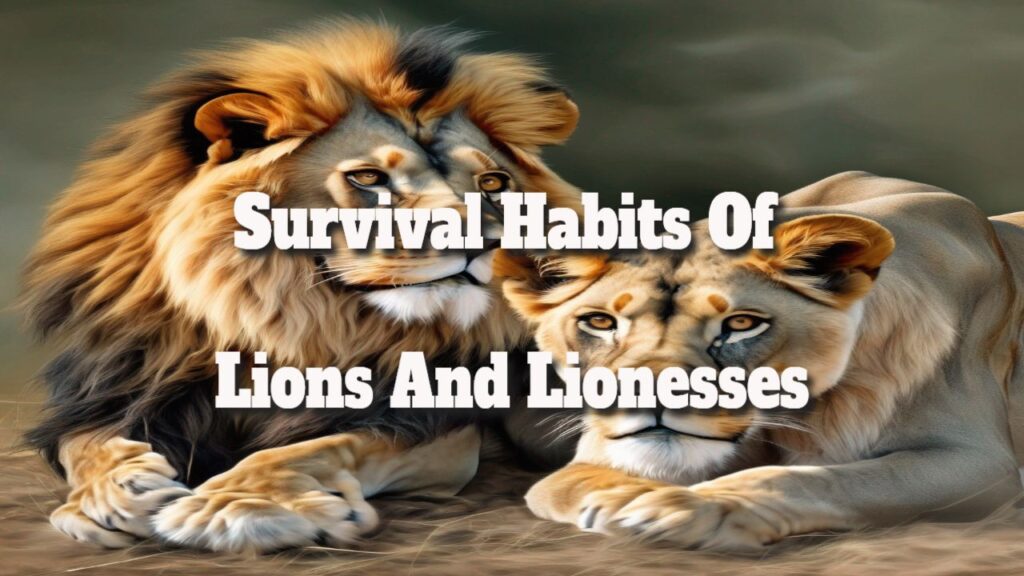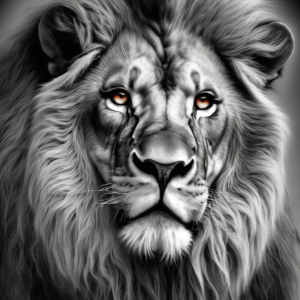Explore the Essential Survival Strategies of Lions and Lionesses
Lions and lionesses stand out as some of the most captivating animals on our planet. Renowned for their immense strength, bravery, and exceptional hunting prowess, these majestic big cats have intricately evolved survival skills that enable them to flourish in their natural habitats. A deeper understanding of these survival behaviors reveals how they navigate the complexities of the wild, secure food, and maintain their social structures, showcasing their remarkable adaptability and intelligence.
One of the most crucial survival strategies employed by lions and lionesses is their innate ability to collaborate effectively within their social groups, known as prides. Typically, a pride comprises several mothers raising their cubs alongside a few dominant males. Lions are inherently gregarious animals, with each lioness assuming a specific role that contributes to the pride’s overall success. Through teamwork, they efficiently hunt, defend their territory, and nurture their young, making this cooperative effort vital for their survival, allowing them to tackle larger prey and ward off potential threats.
Another critical aspect of survival for lions and lionesses is their outstanding adaptability. These remarkable creatures can thrive in a wide range of environments, including expansive grasslands, arid deserts, and dense forests. Their hunting tactics are flexible, adapting to the availability of prey in their surroundings. For instance, if larger game becomes scarce, they may shift their focus to smaller animals or even scavenging. This remarkable ability to adjust to changing conditions is essential for their long-term survival in the wild.
Understanding the Social Dynamics of Lion Prides
Lions are inherently social felines that form cohesive, structured prides, which are crucial for their survival. A typical lion pride consists of multiple females, their offspring, and a small number of males. In this section, we delve into the intricate social dynamics of lion prides, examining the distinct roles that lionesses and male lions play in maintaining the pride’s stability and success.
The Vital Hunting Roles of Lionesses in the Pride
Lionesses serve as the primary hunters within the pride, showcasing exceptional teamwork in their pursuit of prey. Collaborating closely, they strategically stalk and ambush their targets, sharing the spoils with the entire pride after a successful hunt. In addition to their hunting duties, lionesses take on the critical responsibility of nurturing the cubs, protecting them from potential dangers, and imparting vital hunting skills. These highly social creatures form deep bonds with one another, often engaging in grooming and playful interactions that strengthen their unity.
Understanding the Hierarchical Structure of Male Lions
In contrast to the lionesses, male lions have unique responsibilities within the pride. Their primary role is to defend the pride’s territory against rival males, ensuring the safety of the females and their cubs. Males also engage in mating with the females, perpetuating the pride’s genetic lineage. However, not all males enjoy equal standing; a strict hierarchy exists, with the dominant male, often referred to as the “alpha male,” at the top. This alpha male enjoys first access to food and mating opportunities and leads the pride in hunting and other collective activities.
Overall, the social structure of lion prides is intricate and deeply organized, where each member fulfills a specific role. This cooperation and organization are vital for the pride’s survival and overall success in the challenging wild.
Mastering Hunting Techniques and Target Prey
Utilizing Teamwork in Hunting Strategies
The exceptional hunting skills of lions have earned them a reputation as one of nature’s fiercest predators, especially when they collaborate as a cohesive team. Prides, which consist of multiple females, their cubs, and occasionally a few males, engage in coordinated hunting efforts. The lionesses take on the primary hunting role, while the males focus on protecting the pride and maintaining territorial integrity.
Lions employ an array of sophisticated strategies while hunting to increase their chances of success. One prevalent technique involves encircling the prey and launching attacks from various angles, leveraging their strength and sharp claws to subdue the animal. This method proves particularly effective when targeting larger prey, such as buffalo or zebras, which require teamwork and strategic planning.
Another compelling strategy involves working in concert to exhaust their prey. The lions chase the animal, compelling it to run in circles until it can no longer sustain its speed. Once the prey is fatigued, the lions close in for the decisive kill, demonstrating their prowess as apex predators in the animal kingdom.
Expert Stalking and Ambush Techniques
In addition to their team hunting strategies, lions masterfully employ stalking and ambush tactics to capture their prey. This method entails stealthily approaching the target while remaining concealed behind natural cover, such as tall grass or dense bushes, before launching a surprise attack when the prey is least aware. This approach is particularly efficient for hunting smaller animals like gazelles or impalas, where agility and surprise are paramount.
Patience is another hallmark of a lion’s hunting strategy. Lions can spend extended periods waiting for the opportune moment to strike, often remaining motionless until their target comes within reach. This level of patience and stealth is crucial because any unexpected noise or movement could alert the prey and cause it to flee, thus compromising the hunt.
Ultimately, lions are highly skilled hunters equipped with diverse techniques that enhance their hunting efficiency. Their ability to collaborate as a team, coupled with their patience and stealth, positions them among the most formidable predators in the animal kingdom.
Territorial Behaviors and Natural Habitat Preferences
Defining and Protecting Territory
Lions are well-known for their distinct territorial behaviors, which play a crucial role in their survival. A pride of lions will vigorously defend its territory against incursions from rival prides and other predators. They establish their boundaries through various methods, including urination, marking with their scent glands, and vocalizations such as roaring. These scent marks and roars serve as a clear warning to other lions, signaling them to steer clear of established territories.
Lionesses take on the primary responsibility for marking and defending their territory. They patrol the pride’s boundaries, consistently marking the area with their unique scent. Additionally, lionesses exhibit fierce protective instincts, defending their territory against threats from other predators, such as hyenas and leopards, ensuring the safety of their young.
Adaptability Across Diverse Environments
Lions are remarkably adaptable creatures, thriving in various habitats ranging from sprawling grasslands and savannas to dense forests. Their ability to adjust to different environments is evidenced by changes in their hunting and social behaviors, which reflect the local conditions and prey availability.
In areas with thick vegetation, lions often hunt in smaller groups, utilizing the concealment offered by the foliage to ambush their prey effectively. Conversely, in open grasslands, they tend to hunt in larger groups, capitalizing on their speed and stamina to chase down prey. This adaptability is vital for their survival, allowing them to navigate the challenges of different ecosystems.
Overall, the combination of territorial behavior and adaptability to diverse environments constitutes essential survival habits for lions and lionesses. By marking and defending their territory and adjusting their strategies to suit their surroundings, they can continue to thrive in the wild.
Reproductive Strategies and Cub Development
Engaging in Mating Rituals
Lions and lionesses exhibit a polygamous mating system, engaging with multiple partners throughout their reproductive cycles. The mating season typically occurs between August and November, during which lionesses experience estrus for four to six days. During this fertile period, lionesses mate with several males, increasing the likelihood of successful pregnancies and genetic diversity within the pride.
Male lions often compete fiercely for the opportunity to mate with a lioness, resulting in intense confrontations that can lead to injury or even death. The victorious male will mate with the female repeatedly over several days, ensuring that his genes are passed on to the next generation.
Nurturing Cub Survival Skills for the Future
Once lion cubs are born, the lionesses assume the primary responsibility for their upbringing. Weighing merely three pounds at birth, cubs are born blind and vulnerable, relying entirely on their mother for nourishment and protection. The mother’s guidance is crucial in ensuring their survival during these formative weeks.
Typically, lionesses give birth to a litter of two to four cubs, nursing them for approximately six months. During this early stage, lionesses impart essential survival skills, such as hunting techniques and socialization with other pride members. The nurturing environment fosters the cubs’ development, preparing them for the challenges that lie ahead.
As the cubs mature, they accompany their mothers on hunts, gradually learning the skills necessary to stalk and capture prey effectively. Lionesses also teach their young how to navigate social interactions within the pride and defend themselves against potential threats. This comprehensive education is vital for the cubs’ long-term survival in the wild.
Overall, the survival of lion cubs heavily relies on the care and guidance provided by their mothers. Through dedicated nurturing and teaching, lionesses equip their cubs with the necessary skills to thrive and succeed in their natural environment.
Current Conservation Status and Emerging Threats
Addressing Human-Wildlife Conflicts
Lions and lionesses face a multitude of threats stemming from human activities, including habitat loss, poaching, and retaliatory killings due to conflicts with livestock. As human populations expand and encroach on lion habitats, the likelihood of encounters between humans and lions increases. Farmers may resort to killing lions to protect their livestock, while lions may attack humans in retaliation for habitat encroachment and hunting.
Proactive Conservation Initiatives to Protect Lions
Numerous conservation initiatives have been launched to mitigate these threats and protect lion populations for future generations. Establishing protected areas, such as national parks and wildlife reserves, provides crucial sanctuaries where lions can thrive safely. Additionally, anti-poaching measures aim to deter illegal hunting and trade of lions and their body parts.
It is essential for both conservation groups and local communities to collaborate to foster a harmonious coexistence between lions and humans. This partnership includes providing education and resources to farmers, enabling them to protect their livestock without resorting to lethal measures. Implementing strategies to minimize human-lion conflicts, such as physical barriers and deterrents, is crucial for long-term sustainability.
While lions and lionesses confront significant challenges from human activities, ongoing conservation efforts are dedicated to preserving these magnificent creatures and ensuring their survival for generations to come.
The post Survival Habits of Lions and Lionesses appeared first on https://gqcentral.co.uk
The Article Survival Habits of Lions and Lionesses was found on https://limitsofstrategy.com





This exploration of the survival strategies of lions and lionesses is not only fascinating but also profoundly relatable when we think about the lessons we can take from their social structures and cooperative behavior. The concept of pride dynamics is emblematic of how communities, whether in the animal kingdom or within human society, thrive through collaboration and mutual support.
You bring up such an interesting point about pride dynamics and how they mirror our own communities. It’s really fascinating when you think about it—the way lions and lionesses work together is all about finding that balance between individual strengths and collective strength. Each member of the pride has a role that ties into the larger picture, whether it’s hunting, protecting the territory, or raising the young. It’s like a well-orchestrated team where everyone plays an important part.
The strategies employed by lions and lionesses within their prides are indeed a fascinating example of social cooperation in the animal kingdom. Their collaborative hunting techniques remind me of some human communities where teamwork is essential for survival, particularly in challenging environments.
You bring up such an interesting point about the parallels between lion behavior and human teamwork. It’s pretty incredible how both species adapt to their environments by relying on one another. In lion prides, the division of roles really stands out—lionesses do a lot of the hunting, while males have that protective role. It’s like everyone has their strengths, and they play to them, which can remind us of different roles in our own communities.